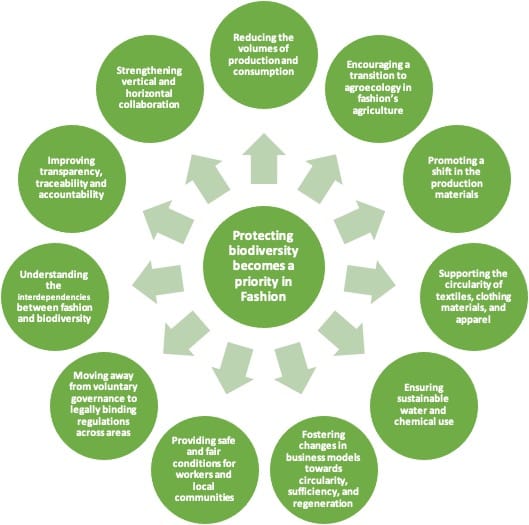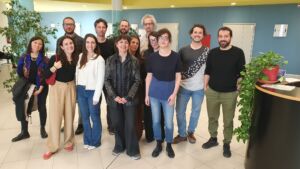Location: Italy, Tuscany
Lead Partner: University of Pisa
Involved partners:
Dario Casalini, Slow fiber, Funder (a network of Italian companies covering the entire fashion and home textile supply chain)
Valentina Ceriani, Sustainable manager, Antiba Luxury Tannery, (SME)
Deborah Lucchetti, President Faircoop (NGO, Clean Clothes Campaign)
Silvia Gambi, Sector journalist
Giuseppe Ungherese, Responsible for Detox Campaign Greenpeace Italy (NGO)
Giovani Graziani: Environmental and Sustainability Consultant
Isabella Pratesi, WWF Italy (NGO)
Mara Cossu, Lorenza Emili- CNR – Ministry of Environment and Energy Security – Sustainable Development Strategy
The high specialisation and simplification of most mainstream fashion value chains, as well as the enormous material resource use and the quick obsolescence of fashion products, are threatening biodiversity and undermining people, climate, and our planet. Some of the critical negative impacts of the fashion industry include contributing to soil and land degradation, deforestation, desertification, land conversion and pollution, and declines in plant and animal populations.

Textile workshop tour
Reducing the impact on biodiversity (e.g. using less harmful chemicals and land use in the production of raw materials) requires a wholesale change in the business models of the fashion industry, behaviour and the relationships among producers, workers, consumers, and the environment.
This case study will explore the Tuscan fashion system, including networks of critical and alternative consumption, work, and production. The case will support social actors, companies, and public institutions to discuss, learn and find transformative change as a means to integrate (prioritise) biodiversity protection within socio-economic activities, such as product redesign, and transformation of different eco-social relationships with the environment.

Rethinking Fashion for Biodiversity
The main aim is to understand the connection between biodiversity and the fashion system and explore pathways to transform the fashion industry.

Case Study Advisory Group
Expected impacts
Individual level
“Repair is the New Cool” and “Less is More”. We expect to be part of the development and publicity of a “new fashion culture” which is not just based on quantity, profits, and prices but also on social (quality of life and wellbeing) and environmental issues (such as biodiversity) as priorities. With the development of our action-research activities in direct contact with key stakeholders and the divulgation of our results, we hope to send clear, strong, and informative messages to consumers, practitioners, and policymakers so that biodiversity becomes a higher priority in their individual decisions.
Community level
By analysing the broader global fashion system and some local realities (e.g., small business, local fibre production) that are trying to contest the status quo, we expect to contribute to their visibility and use their experiences to inform similar realities to flourish and develop. We anticipate some of our policy recommendations may favour local producers and service providers, thus helping the local labour market and circular economy.
Institutional/Policy level
The case study examines the current fashion system and its transition dynamics, aiming to understand which strategic interventions can contribute to leverage existing dynamics to move the system towards a “good fashion” system that prioritises biodiversity and equity.
Biodiversity
By providing input about potential alternative business models, and less impactful consumption and production practices for the sector, the case study aims to help actors (policymakers, consumers, producers) to better prioritise biodiversity in their decision-making. In the long term, this can contribute to reducing the sector’s ecological footprint and to causing less damage to ecosystems and biodiversity.
Intersectionality dimensions
Gender (i.e., 80% of the sectors’ workers are women).
Migration (i.e., migrant workers are mainly employed in lower paid jobs).
Age, generational gap (i.e., younger generations have more environmental awareness).
Economic class (i.e., labour conditions, sustainable fashion is expensive).
Working approach
Systematic targeted literature review on biodiversity impact of the fashion industry.
Review of business and civil society initiatives explicitly addressing the topic of biodiversity in the fashion sector.
Action research framework aiming at the collaborative production of scientifically and socially relevant knowledge through a participatory process.
Explorative interviews and focus groups with key informants.
Advisory board creation with key experts to confront and discuss our results and develop new insights.
In-depth qualitative case-study analyses involving companies with strategies/initiatives with potential to prioritise biodiversity.
Workshops with different methods, e.g., problem setting and scenario creation for a fashion-biodiversity transition (e.g. X curve), biodiversity role playing, filmmaking.
Interventions: identify levers for transformative change towards biodiversity prioritisation in fashion industry. This process results in a narrative of change and action points that we might call a “Biodiversity Transition Fashion Agenda”.
Publications
Rethinking Fashion for Biodiversity
What should we wear on a planet in peril
Biodiversity prioritisation in Textile, Apparel, and fashion. A short introduction
25 March 2024- Moda e biodiversità: un futuro sostenibile? Seminario del progetto PLANET4B
https://www.vogue.it/moda/article/biodiversita-moda-sostenibilita-ecosistemi
Textile Exchange Biodiversity Benchmark
Moda e sostenibilità, Il Raporto Baine
